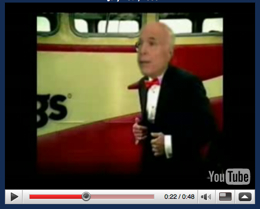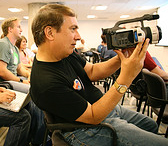
You just created the best video mash-up ever, taking a speech given by John McCain broadcast on Fox News, remixing it with the song “Ol’ Man River,” and quick-cutting in clips from gangsta rappers. You upload it to YouTube and other video-sharing sites, and watch the views pile up. But have you run afoul of copyright law? Do you really have permission to use that video footage or music? Or does it fall under the fair use doctrine in U.S. copyright law?
It’s an oft-asked question, and one that has new meaning as Google/YouTube battles a $1 billion lawsuit over copyright violations. When YouTube sends out take-down notices for videos that use copyrighted material, they often ensnare legal fair use of video, in cases where the producer might be commenting or critiquing material, capturing copyrighted material incidentally, or recombining material for a new meaning (as in this case above).
So the Center for Social Media (CSM) at American University decided to help video producers, remixers and video-sharing sites by bringing together a panel of legal experts and academics to come up with a Code for Best Practices in Fair Use for Online Video. The idea is to set out some basic guidelines, bust some myths (e.g. “If I’m not making money off it, it’s fair use”) and spread the word about the legality of some video mash-ups.

The CSM modeled this new Code on a previous Documentary Filmmakers’ Statement of Best Practices in Fair Use, which has helped documentary makers navigate fair use questions.
I decided to convene my own panel of academics (some of whom had worked on the Code), video remixers and video-site proprietors to find out how the new Code of Best Practices might help spread the word about fair use in online video. This was a “virtual roundtable” that took place by email over the past week. The following is an edited version of the first part of that email discussion. (I invited representatives from YouTube and Veoh to participate, but they declined.) I’ll be running the second and third parts of this conversation in later installments on MediaShift.
What do you think the Code will accomplish? We have Viacom suing YouTube and we have a lot of video usage online that includes mashups, remixes, social commentary, and satire using copyrighted video. Can this guide help bring about more clarity on fair use in online video? If so, how?
Peter Jaszi
law professor at American University and co-chair of the Code of Best Practices committee
We certainly hope so. Just as the Documentary Filmmakers’ Statement of Best Practices in Fair Use (released in November 2005) has brought new clarity to that creative environment. My sense is that the real dispute between Viacom and YouTube isn’t (and never has been) about “fair use” videos, but about the uploading of large chunks of untransformed current video. But there is a real risk that new creativity could be an incidental casualty of the outcome of this litigation — however it is resolved.
Everyone in this environment seems to agree in general terms that fair use should be respected, though not necessarily on what fair use is. This Code — in addition to providing practical guidance to video makers — should move us toward a robust common understanding of what kinds of video-making should be fostered rather than suppressed.
JD Lasica
co-founder of Ourmedia media-sharing site, new media expert and videoblogger
When we launched Ourmedia.org, one of the first video-hosting sites, back in March 2005, we didn’t have a compass or a flashlight, much less a roadmap. We had 80 volunteer moderators in 14 countries keeping an eye on all new content and working in a wiki to decide which items to remove and which fell under murky fair use standards. If a call was borderline, we would leave it up. That kind of individual review doesn’t scale — for large video sites, it just isn’t possible in a world where people are now uploading hundreds of thousands of videos every day.
We worked with Fenwick-West, the intellectual property law firm, to craft a set of fair use guidelines for the digital age because we thought it was important for users to know in broad terms what they could legally share or not — without having to attend law school at night.

In the past three and a half years, the personal media revolution has produced astonishing new forms of participatory culture, from video mash-ups to annotated commentary. To see how far we’ve come, take a look at one of the stories I recounted in my 2005 book Darknet. Donald Whiteside, an Intel vice president, had broken federal law by ripping a few seconds of the commercial DVD “Rudy,” adding the music soundtrack “Who Let the Dogs Out?” and splicing in footage of his 9-year-old son’s Pop Warner team.
Today, that wouldn’t raise an eyebrow when millions of other people borrow from the culture to create and share their own personalized, non-commercial works. The culture is expanding our ideas about what fair use encompasses. There’s a sensible space between all-rights-reserved permission culture and a culture where the rights of creatives are not respected. Ultimately, society — not Congress, not the courts — will determine the contours and limits of remix culture. The new Code Best Practices is the most thoughtful analysis of this new landscape that I’ve seen.
Anthony Falzone
executive director of the “Fair Use Project”: http://cyberlaw.stanford.edu/node/3136 at Stanford University
JD hit an important point. Nobody seems to acknowledge the terrific burden the copyright system places on ordinary people. We have sophisticated (and relatively cheap) tools to create and share video content on a massive scale, but almost no guidance on what we’re allowed to do with copyrighted content in that realm. Fair use largely defines those rights, but it’s not an easy tool to use for anyone but a legal specialist. So most people are left to guess whether and how it might help them.
At a minimum, I expect the Code will help people across the spectrum figure out whether their creations are likely to fall on one side of the fair use line or the other, both in deciding whether and how to share it, and whether to defend it if challenged. Beyond that, I hope the Code will help platform providers and content owners — the YouTubes and Viacoms of the world — reach a common understanding of what’s fair use and what’s not so they can go beyond the generalities Peter mentioned.
Francesca Coppa
director of film studies, Muhlenberg College; founding member of the Organization For Transformative Works
I think that the Best Practices will spread rapidly and widely through online creative communities and stop some of the ‘chilling effects’ produced by random take-downs by sites like YouTube and iMeem. For example, even within the last year, education about fair use has led some vidders to question or protest take-downs when they happen, and some videos have been restored — or permission explicitly granted for re-upload. But it’s crucial that vidders and other makers know their creative work is legitimate.
Owen Gallagher
digital media entrepreneur; founder of TotalRecut, a network of fans and creators of video remixes, recuts, and mash-ups
I think this document is a very positive step toward a stronger general consensus regarding what is acceptable in terms of appropriating copyrighted content, and what is not. In an area where there is so much confusion about what you can and can’t do (thanks primarily to frivolous legal threats from the major media companies), I believe this to be a very important and much needed document which will hopefully help to reduce the ‘chilling effects’ that Francesca refers to.
The biggest problem in this space is that videos making legitimate reuse of copyrighted material are being caught in the crossfire in the ‘war on piracy.’ For example, Google’s filtering technology for YouTube often wrongly identifies remixed videos as copyright infringements, but thankfully more and more people are beginning to realize that they can challenge these claims by filing counter-notifications.

Viacom’s lawsuit against Google may result in less outright piracy and uploading of complete copyrighted works to YouTube, but whichever way the case goes, I do not believe for one second that the creation of video remixes, mash-ups and other such transformative works will be stifled in any way. This is a form of creative expression that is growing in popularity every day and will eventually snowball into a critical mass of truly mainstream activity.
Copyright laws will eventually have to be adapted to suit this new landscape and before that happens, as JD mentioned, it will be society, not the courts, who will decide what is acceptable and what is not. I feel that the Code of Best Practices is an important step in establishing a balance between the copyrights of original content creators and the freedom of expression rights of those who wish to build on the works of the past.
rx
political video mash-up artist at ThePartyParty.com
While I personally found the document helpful in clarifying fair use, I’m not sure what effect, if any, it will, or should have on artistic expression. As an “artist,” the last thing I’m thinking about when working on a project is the law. In fact, I don’t consider any of that until too late, as I think is best. An artist should pursue his or her vision, regardless of bureaucracy, regardless of consequence. It’s the “suffering for your art” principle.
Part of our role as new media artists, I believe, beyond the intended value of a given work, is to challenge old fashioned ideas of intellectual property rights and free speech. In these days where the president’s spokesman is on TV saying “Americans had better watch what they say,” firmly planting the flag in defense of freedom of speech is our responsibility. If anything, perhaps the Best Practices can help the art market better understand which works are legit and which are not, and that can be a big help to artists who are trying to establish a market for their work, and therefore carry on as artists.
Mizuko Ito
research scientist, School of Cinematic Arts, University of Southern California
In addition to the clarifying role that this document performs in helping people understand legal doctrine, I think this document also is important in providing a reference point and a focus for discussion, debate, and coalition building. I’ve been doing work researching youth Internet use and video remixes, mostly fan-based, and so this comes from my position as an observer of everyday video creation and circulation. When I forwarded this document to various members of remix communities I’ve been in contact with, most people said they had already received it from multiple sources.
Subsequently, there has been lively debate on various web forums and mailing lists about the meaning of the document for specific video creation practices. In other words, the circulation of this document gives disparate communities a focus for discussion and reflection on meta issues that are not generally part of day-to-day conversation. It also provides a focus for understanding how the interests and issues of these diverse groups are actually linked.
I think rx’s point that the law is generally an incidental consideration for creators is an interesting one. I would agree. I think that is particularly true for non-professional video creation, which is often not made with the intention to circulate widely or commercialize. My observations have been that the legal considerations come in primarily at the point of distribution and circulation — when people try to figure out where they can post or show their videos. This document should be useful in helping people navigate those set of decisions.
*****
Thus ends Part 1 of the roundtable. Part 2 will look at how people might spread the Code to video producers and how video-sharing sites might help educate people about fair use. Part 3 is a discussion on whether copyright law should be changed in order to better protect fair use.
What do you think about the Code? Do you think it’s a good document for outlining fair use? Should video sites such as YouTube post it somewhere prominently? How could the code be improved? Share your thoughts in the comments below.
